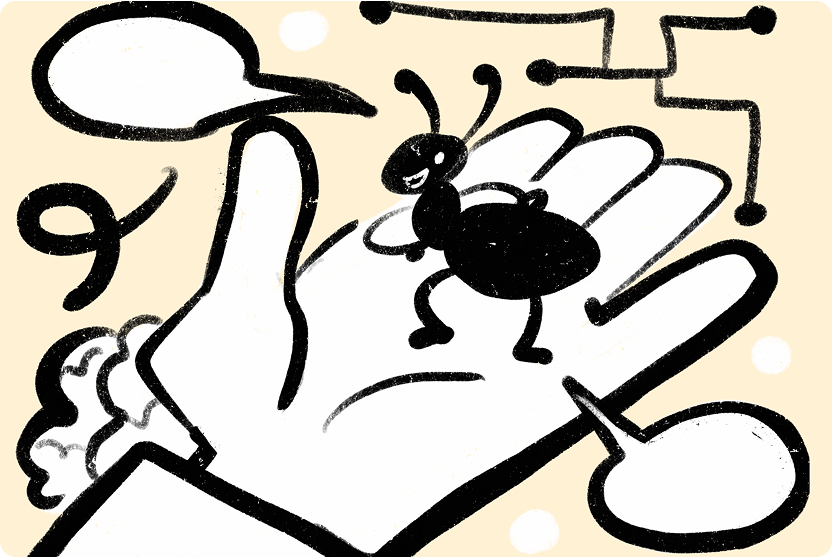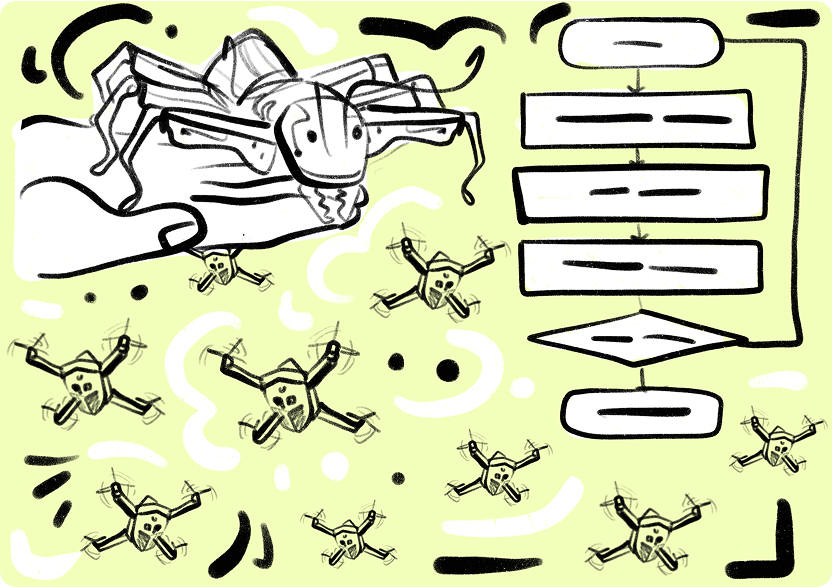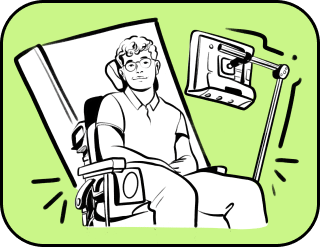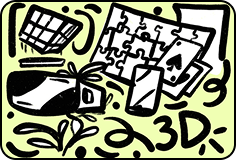Category: Life technologies
How ants count: math and technologies of the anthill
“When a human copies nature—it is science. When nature copies a human—it is the apocalypse”
Anonymous environmentalist
From early morning, the Anthill hums with measured activity: some gather food, others dig tunnels, and a third group cares for the larvae. Meanwhile, in the Humanhill, Human number 4737 scrolls through his phone: twelve missed calls, fourteen notifications, and three emails marked “urgent.” He sets the phone aside and rushes out of the house, realizing that before work he’ll spend hours stuck in traffic: time will be wasted, but tasks will remain. And so it goes, day after day.
What would an Ant say about this? Really, what would an Ant say?
How, without maps or satellite navigation, can one optimize any route? How, without blueprints, can one build a skyscraper with first-class ventilation, temperature regulation, and drainage?
How, without bosses or a governing body, can one create a system of labor distribution? And how, while staying in the role of a drone, can one remain human?
We’ll give answers in both everyday and technological terms.
The Arithmetic of Daily Life
Still sitting in his car, the Human leaned back and turned on the radio. The thought of starting a dialogue with an Ant struck him as both amusing and strangely sensible.
‘How do you even find your way without maps or navigators?’ he asked his imaginary Ant, recalling how once, while looking for the right house with some friends, they had followed a GPS that led them astray at a giant stump. They then tried “going by memory” and ended up in a dead end—a sort of human-made ant trap. Clearly, the problem wasn’t the technology but something more fundamental.
‘You’ve only walked three hundred steps away from your world,’ replied the imagined Ant. Desert ants, it turned out, carry a built-in pedometer in their heads: if you experimentally lengthen their legs, they’ll miss the nest by exactly those “extra” centimeters.
‘And you?’ asked the Ant. ‘Would you remember the resinous smell of that oak or the tapping of the woodpecker to the left? No, you blindly trust the screen that deceives you. Turn off your navigator. Walk ten steps—look back. Your own brain creates maps better than any satellite.’
The Human switched off the ignition; along with it, the radio and navigator went silent.
‘Progress!’ laughed the imaginary Ant. ‘Your brain has long been asleep. Wake it up.’
The Geometry of Space
The Human absentmindedly glanced at his phone. ‘Okay, Google, what does an anthill look like?’ Every anthill stunned him with its geometric perfection: each tunnel, each chamber was drawn as if with ruler and compass. Ants, it seemed, were born geometers. In their membranous-winged world, they had long ago discovered the perfect form: the hexagon—the very same used by bees in their honeycombs, and by ants in their underground megacities. Nature didn’t choose this shape by accident: the hexagon saves material, withstands enormous pressure, and leaves almost no wasted space.
‘Why don’t you stack your shelves like honeycombs?’ suggested the imaginary Ant. ‘In your wardrobe, 30% of space is wasted, while with us not even a crumb is lost.’
But the greatest secret of ant geometry lies in the angles. Most ants dig their tunnels at a precise angle: about 60°, the golden balance between ease of movement and structural strength.
The human absentmindedly looked at their phone. “Okay, Google, what does an anthill look like?” Each anthill was striking in its perfect geometric harmony: every tunnel, every cell was drawn as if with a ruler and compass. It turned out that ants are born geometers. Their wings, delicate and translucent, balanced between ease of movement and stability. Humans, of course, can discover the same principle—but usually only after five years in an architecture program.
‘Why complicate things?’ twitched the Ant’s antennae. ‘Move your couch at 60° to the window: the light will fall just right, and the view will be perfect. Even the hanger in your closet can be set at that angle—your clothes won’t wrinkle.’
For those who have forgotten what this magical angle looks like, the Ant offered a simple trick: fold a sheet of paper in half, then once again diagonally. Done!
The Ant Formula of Resilience
‘You’ve locked yourselves into one path,’ the Ant touched on the theme of crisis. ‘We never keep all our eggs in one basket. Even if the colony finds a perfect food source, 20% of ants still continue to explore alternative routes. At first glance, it seems like a pointless waste of energy, but when the main “supermarket” suddenly disappears—devoured by a greedy anteater—the colony already has backup options. Humans, obsessed with optimization, trap themselves: one route means traffic jams, one store means shortages, one source of income means crisis.’
The Ant suggested having “scouts”: 20% of a company’s employees dedicated to trial projects (that’s how Gmail and AdSense were born), keeping 20% of reserves for a rainy day (water, food, medicine), and always having something extra: an alternative route, a backup skill, or even a strange hobby—who knows, it might become a profession one day. At the same time, he praised humans, ‘You turn crises into opportunities—like remote work during the pandemic. But why wait for a crisis?’
The ant principle is simple: true efficiency is not one perfect path, but a network of options.
Communication Without Toxicity
In the anthill, it turns out, there is no such thing as a “zone of responsibility.” Instead of fixed job titles, there are only roles: today you forage, tomorrow you build, the day after you babysit larvae.
‘Funny things, these résumés of yours,’ remarked the Ant. ‘Our CV updates every morning. Try it: let the marketer wash the mugs sometimes, and the CEO carry boxes. It’s not chaos, it’s flexibility.’
But the most important thing is communication. Ants manage without meetings: leave a pheromone trail—colleagues get the message. The more often a path is used, the stronger the trail. Humans, however, need chat messages, stickers, voice notes, and a recipient’s nervous twitch just to answer a simple question like “Where’s the coffee?”
‘Cut your messages down to 50 words,’ the Ant suggested. ‘Didn’t fit? Then the issue requires a meeting. And, for the love of chitin, stop sending emails “for information”! We don’t leave pheromone marks for no reason.’
The only area where he admitted human superiority, ‘At least you can joke in chats. Our pheromones can’t convey sarcasm. Yet.’

Swarm Algorithms
‘You complain about inefficient communication,’ said the Ant. ‘Yet you’ve copied our main tool! You called it “swarm intelligence” instead of “let’s just follow that guy who looks like he knows where he’s going.”’
Indeed, computer engineers borrowed from ants a brilliant mechanism that has worked reliably for 150 million years, and proudly “rediscovered” it in 1992, winning a Turing Award for this “revolutionary” invention. Instead of chemical pheromones that mark optimal paths, programmers created digital analogues—virtual markers that replicate the principles of natural selection. Today, these insect-inspired algorithms run our digital civilization: Amazon’s logistics systems build delivery routes the same way forager ants do; 5G networks balance loads by imitating task distribution in the anthill; machine learning systems use “swarm” principles to optimize neural networks.
Nature created this mechanism without servers, programmers, or billion-dollar investments—through endless cycles of trial, error, and evolutionary selection. As Marco Dorigo, the creator of the ant colony algorithm, once said: ‘We didn’t invent anything new—we just learned to read the oldest engineering book ever written, authored by nature.’
But here appeared a typically human paradox: ‘You took the technology but missed the philosophy,’ noted the Ant. ‘Your Waze, by sending everyone down the same ‘optimal’ route, just creates new traffic jams. The principle ‘don’t have 100 identical routes, have 20% scouts’ works in technology too. Either you let the system wander sometimes, or your perfect route becomes a puddle. Strict planning is the enemy of optimality.’
And indeed, the most groundbreaking technologies often emerge at the intersection of strict logic and healthy chaos. Of course, ants never have to pay server bills.
If ants demanded royalties for their patents, the entire IT sector would be bankrupt. Luckily, they settle for crumbs from our tables—literally and figuratively.
Decentralized Systems
‘Let’s test another of your “breakthrough technologies” for ant-compatibility,’ suggested the Ant, examining a blockchain diagram. ‘It has no central authority, and all nodes are equal. But explain to me… these “miners”?’
An ant colony is the benchmark of a distributed system. There is no central server, no king—only equal individuals making decisions through pheromone consensus. Blockchain was conceived in the same way: every node in the network is a full participant, with truth emerging from cryptographic trust, not authority.
But instead of digital utopia came Feudalism 2.0, where 1% of miners control 50% of the power. Giant farms in Iceland, like ant-oligarchs who seized all the aphid pastures, devour the energy of entire nations. “Decentralization” turned into an arms race: whoever owns more ASIC miners rules the blockchain. Crypto “kings” build underground bunkers for their farms, knowing that ordinary nodes cannot compete and die off—like ants without pheromones.
In the ant world, queens sometimes emerge too, but nature quickly restores balance, often in the form of a hungry bird. Over 150 million years, nature has mastered self-regulation. Blockchain, by contrast, still resembles 19th-century wild capitalism, where the winner is not the smartest but the greediest.
Nature does not tolerate concentration of power—not in cryptocurrencies, not in the anthill. Some resist it through endless hard forks, others through natural selection. And so far, nature is winning. Real decentralization requires three things: equal access, frequent role changes, and absence of greed—but sadly, that’s not about Homo sapiens.
If Satoshi Nakamoto had borrowed from ants not only algorithms but also mechanisms for restraining monopolies, perhaps today we’d already be living in a perfect Web3. But things turned out as usual.
Bionics in Action
When the conversation turned to mechanical counterparts, the Ant perked up, ‘Well then, show me how you reinvented us!’
From Zurich to Tokyo, engineers have spent years trying to replicate a simple ant ability: carrying loads 50 times their own weight. So far, the best results are six-legged walkers that imitate the “ant gait,” mini-robots with adhesive feet that climb walls, and bionic grippers inspired by ant mandibles.
But there’s a problem: robots don’t have chitin joints. Their “muscles” are buzzing servomotors, hungry for batteries.
“Oh!” exclaimed the Ant, looking at drones. “Those are just our foragers—but with propellers!”
Indeed, drone coordination algorithms almost exactly repeat ant logic: they are programmed for self-healing routes, distributed tasks, and automatic load-balancing when part of the group is lost.
But again, a catch. In an emergency, an ant simply bites an aphid and keeps going. A drone, on the other hand, needs a charging station or a battery swap. A fallen ant crawls on; a fallen drone with broken sensors needs a full repair.
Before leaving, the Ant promised to send blueprints for chitin joints—just in case humans wanted them for the next generation of robots. “We’ve perfected this design for 150 million years,” he said. “Take it, improve it. Just, please, cite the source!”
And while the Human stood in traffic, thoughtfully replaying his dialogue with the arthropod, in laboratories around the world they were busy copying the ant. Evolution smiled: plagiarism is the highest form of flattery.

Linear-arithmetic synthesis is based on sound formation. We’ve synthesized the perfect formula of facts and interest.
Thank you!




